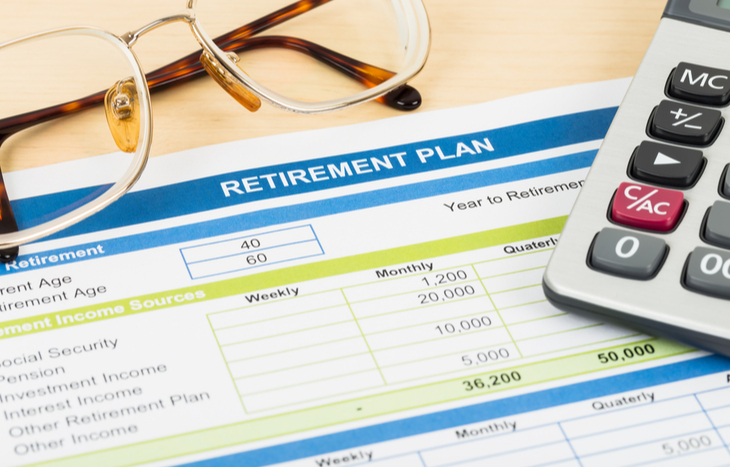Best Retirement Plans – Preparing Your Future
At Investment U, we’re obsessed with the journey to Financial Freedom. It’s what drives our business, and inspires our readers. Selecting the best retirement plan is all part of that journey. Regardless of where you are today, understanding how to prepare for retirement is a key component of financial literacy and your future.
Nearly six in 10 Americans don’t have enough savings to cover a $500 or $1,000 unplanned expense. Meanwhile, the median savings amount is just $5,300. Unfortunately, these statistics mean that many people will be unable to enjoy a healthy, happy retirement unless they make drastic changes. Without adequate savings, it’s impossible to have a comfortable retirement.
When someone is in their 20s, 30s or 40s, retirement seems like a distant dream. While your retirement could be decades away, you have to start saving today if you want to enjoy compound interest and exponential growth over the next few decades. For example… if you had bought just $1,000 worth of Walmart shares in 2010, your investment would be worth 3x that today.
The Best Retirement Plans
To have a secure retirement, you need to start saving money in a tax-advantaged retirement account. Depending on your goals, there are different types of accounts you can choose. Initially, you should talk to your employer about their retirement plans because they may offer matching contributions. If your employer does not offer a retirement plan, you can go to a company like Vanguard or Charles Schwab to start an individual plan instead.
Let’s take a look at some of the best retirement plans and accounts available:
1. Defined Contribution Plans
Most people have heard of defined contribution plans like 401(k) plans. An estimated 100.2 million Americans take part in a defined contribution plan. Other than 401(k) plans, there are also options like a 403(b) plan and a 457(b) plan.
While a 403(b) plan is offered to employees at tax-exempt organizations and public schools, a 457(b) plan is designed for employees who work for local and state governments. Meanwhile, a 401(k) plan is the most popular option and is available for all organization types. All of these plans allow you to contribute up to $20,500 a year in 2022.
These retirement plans are useful because they help you to lower your annual tax bill. Contributions to your 401(k) will not count as taxable income. Until you withdraw your funds, the money can grow without any taxes having to be paid.
2. Solo 401(k) Plans
A solo 401(k) is like a normal 401(k), but it is designed for a business owner and the owner’s spouse. Because the owner is the employee and the employer, they can give the normal contribution of up to $20,500 as well as a non-elective contribution of up to 25 percent of their compensation. The maximum contribution amount is $61,000 for each individual. For unincorporated companies, the maximum limit is 20 percent.
3. Individual Retirement Account (IRA) Plans
With an IRA, you can contribute up to $6,000 in 2021 and 2022. If you are over the age of 50, you can contribute $7,000. Other than a traditional IRA, you can also discover options like a spousal IRA, SEP IRA, SIMPLE IRA, Roth IRA and rollover IRA.
- Traditional IRA: A traditional IRA allows you to contribute pre-tax dollars. This means that each dollar you contribute reduces your taxable income by the same amount. You only have to pay taxes when you eventually withdraw the funds, so they can grow in a tax-free environment.
- Rollover IRA: With a rollover IRA, you can move money from an old IRA or a 401(k) to your new IRA. By doing this, you can continue to enjoy the tax savings of your previous account. You can also choose to switch your account from a Roth IRA to a traditional IRA or visa versa.
- Roth IRA: Unlike a traditional IRA, you contribute to a Roth IRA with after-tax money. While this means you pay more in taxes today, you do not have to pay any taxes on your Roth IRA distributions after you retire. A Roth IRA is considered one of the best retirement plans available.
- Spousal IRA: This kind of IRA is designed for non-working spouses to take advantage of an IRA’s benefits. The working spouse must earn more than the contributions that are made to the IRA.
- SEP IRA: A SEP IRA is designed for small business owners and their employees. Self-employed people can also create a SEP IRA. Employers are the only ones who can contribute, and they can contribute up to 25 percent of the employee’s compensation or a maximum of $61,000.
- SIMPLE IRA: This IRA is a way employers can avoid the non-discrimination tests they are normally required to do for high-paid and low-paid workers. All employees get the same benefits, so the employee’s income is not a factor in determining the contribution percentage. Employers are able to contribute a 2 percent non-elective contribution or a 3 percent matching contribution.
4. Guaranteed Income Annuities (GIAs)
While employers rarely buy GIAs, many individuals add GIAs to their pension plans. With a GIA, you can choose to get a monthly payment after you retire or a lump sum. Some people use deferred income annuities because this option allows you to make ongoing payments before you retire. Each payment increases the amount of money you are paid when you retire. Since many of these plans are purchased with after-tax dollars, you only have to pay taxes on the additional amount your funds earn.
5. Pensions
Pensions are one of the best retirement plans, but many employers do not offer them. Normally, pensions are funded by the employer. After you retire, the pension sends you a fixed amount each month. In the 1980s, about 60 percent of workers in the private sector had just a pension in their retirement plan. Today, that number is down to just 4 percent. An additional 14 percent of companies offer a pension as well as another option. Because of the cost of pensions, many employers do not offer this retirement option any longer.
While there are other retirement options like the Federal Employees Retirement System (FERS), they are less common. In the case of FERS, you have to be a federal worker in order to use the plan. If you are searching for a retirement plan and do not have a pension available, a 401(k) plan or an IRA plan is generally a good choice. You can also talk to your financial advisor to figure out which plan makes the best choice for your situation.
Learn More About The Best Retirement Plans for You
To find the best retirement plan for you, look no further than our free Wealthy Retirement e-letter. To us, a wealthy retirement means having the financial freedom to live the life you want. That’s the goal – and the motivation – behind everything we do. Sign up today and set yourself for a secure future.






